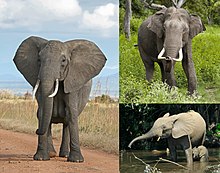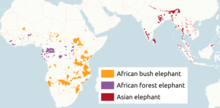
Back Gajah ACE Olifant Afrikaans Elefant ALS ዝሆን Amharic Elefant AN Elpend ANG हाथी ANP فيل Arabic فيل ARZ Elephantidae AST
| Elephants Temporal range:
| |
|---|---|

| |
| From top left to right: the African bush elephant, the Asian elephant and African forest elephant. | |
| Scientific classification | |
| Domain: | Eukaryota |
| Kingdom: | Animalia |
| Phylum: | Chordata |
| Class: | Mammalia |
| Order: | Proboscidea |
| Superfamily: | Elephantoidea |
| Family: | Elephantidae |
| Groups included | |
| |

| |
| Distribution of living elephant species | |
| Cladistically included but traditionally excluded taxa | |
| |

Elephants are large grey animals with big ears, long noses and ivory tusks. They are the biggest living land mammals.[1] The largest elephant recorded was shot in Angola, 1974. It weighed 27,060 lb (12.27 t) and stood 13 ft 8 in (4.17 m) tall.
At birth, an elephant calf may be as big as 100 kg (225 pounds). The baby elephant develops for 20 to 22 months inside its mother. No other land animal takes this long to develop before being born.
In the wild, elephants have strong family relationship. Their ways of acting toward other elephants are hard for people to understand. They "talk" to each other with very low sounds. Most elephants sounds are so low, people cannot hear them. But elephants can hear these sounds far away.[2] Elephants have strong, leathery skin to protect themselves.
- ↑ "African Elephant". National Geographic. Archived from the original on 2012-06-19. Retrieved 2007-06-16.
- ↑ Schwimmer, Rob. "Elephants".